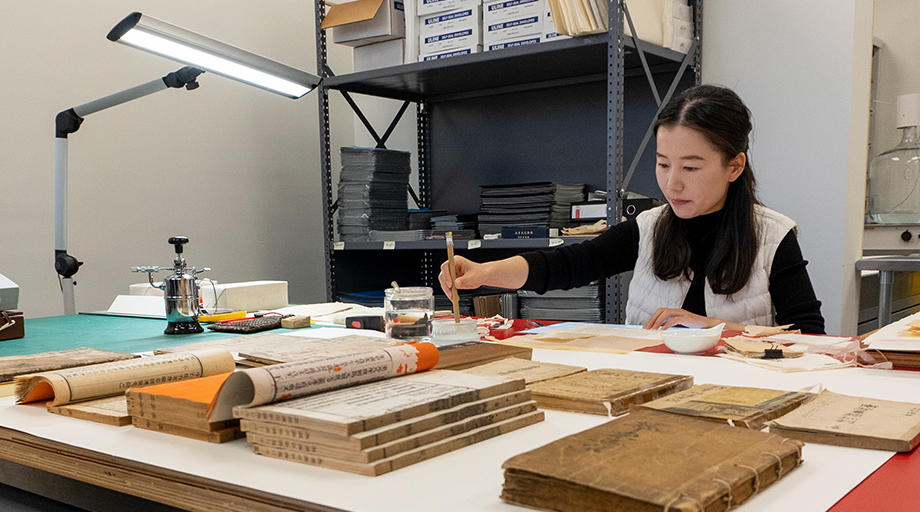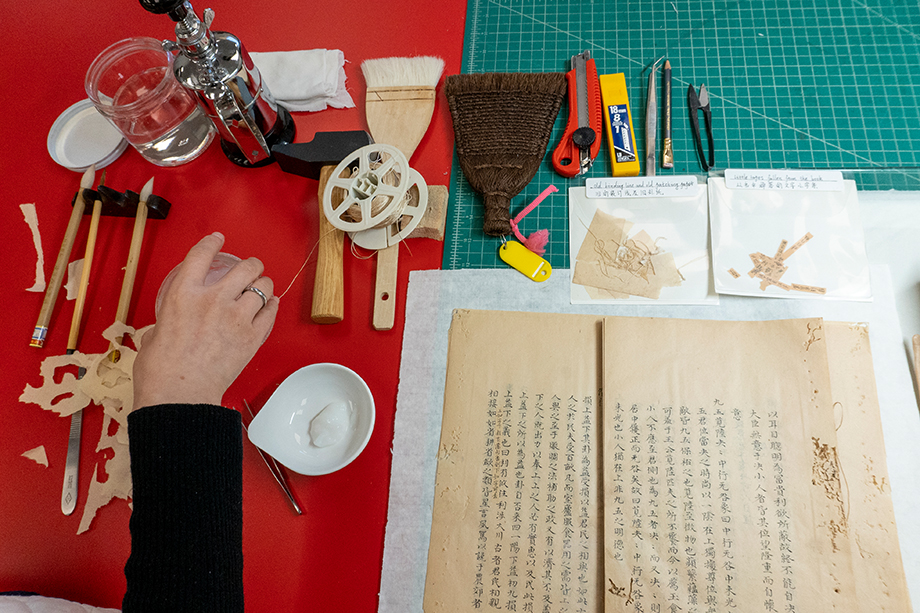
Yan Li is a librarian and rare books Conservator at Fudan University in Shanghai, China. In October, she began her 100-day visit at UBC Library’s Conservation Space, during which she will work with the library’s Conversation and Preservation team. The visit is the result of a memorandum of understanding (MOU) between UBC Library and Fudan University that supports the exchange of Eastern and Western conservation knowledge and skills.
We spoke with Li about her conservation and preservation work at Fudan University and what she is looking forward to most during her time at UBC Library.
Q: Tell us about your role as a Rare Books Conservator at Fudan University. What kind of projects do you work on?
My role as a librarian and conservator includes—but is not limited to—teaching, research and conservation. I have eleven years of experience in the field. I specialise in Chinese rare books, rubbings, and painting conservation. My current research focuses on the adhesives used on Chinese rare books, the reproduction of paintings in rare books and scrolls, and making rubbings. In the past, I have worked on Chinese rare books, sutra and painting.
Fudan University has about 400,000 rare books. Among them, there are about 7,000 titles (60,000 fascicles) that are rare items. Fudan University Library offers a Master’s program on Chinese rare book conservation. Every year there are students from all over the world learning about Chinese rare book conservation. In China, rare book conservation and preservation focuses on learning and understanding the components of the paper, which includes analysing the content of the paper, in order to master various ways of conserving and preserving rare books. Today, Fudan University offers programs on Chinese rare book conservation and preservation.
“My current research focuses on the adhesives used on Chinese rare books, the reproduction of paintings in rare books and scrolls, and making rubbings.”
As one of the first national conservation and preservation centres established in China, Fudan University Library plays a leading role in research, teaching and international partnerships in Chinese rare book conservation knowledge sharing. The conservation and preservation institute currently has seven consultants and seven conservators.
Q: What would a typical day look like for you?
For a rare item that has a conservation plan, my day looks like this. After arriving in the morning, I first start by preparing tools and materials for conservation, especially the preparation/making of adhesives. Adhesives used for repairing rare books are very specific and usually used to be handmade. Depending on the book, the concentration of adhesives varies. It often takes one hour to prepare the adhesives, as well as prepare various repair tools. Conservation of rare books is time-consuming. Depending on the degree of damage, it could take anywhere from two weeks to three months. In some cases with serious damage, it may even take several years to repair.

Image: Rare books conservator Yan Li carefully repairs holes in a damaged page.
Q: What are your goals during your 100-day visit to UBC Library?
There are a lot of things that I wish to accomplish during my 100-day visit. Prior to my arrival, UBC Library conservator Anne Lama proposed a plan for my visit. After I arrived at the library, I realised that UBC library has an extensive Asian collection. The Asian Library has selected rare books in Chinese, Japanese and Korean languages for me. They are all important rare editions.
Currently, I am working on a title from the Puban Collection. While working, I am also documenting each step, both in writing and photos, as future references for the UBC Library conservation team, as I believe that documentation is vital to carry on with Asian rare book conservation. Additionally, Anne and Hannah [Hannah McKendry, Conservation Technician] will teach me Western conservation and preservation.
Q: Are there any items in the Puban Collection that you are looking forward to examining, and why?
At the moment, I am working on the title Xixi Xian Sheng Yi Shuo (西谿先生易說). This manuscript is a rare copy owned by a renowned private library of Yue Xue Lou(岳雪楼) of the Kong Family (孔家), during the last decades of the Qing China. Yue Xue Lou was well known in the Guangdong province, especially for holdings of high-quality hand-copied manuscripts. The manuscript holdings were prized for the accuracy of the content and beautiful calligraphy.
Unfortunately, the manuscript had suffered considerable damage over time. Through a comprehensive process of restoration and digitization, it has been successfully preserved and is now readily accessible to faculty members, students and researchers alike. The manuscript can be explored both in-person and online, offering a valuable glimpse into the rich cultural and historical tapestry of Qing China.
Currently, I have completed the first fascicle and will move onto the second fascicle. My conservation work involves assessing the two fascicles. Xixi Xian Sheng Yi Shuo is currently not in circulation due to its fragile condition and needs to be conserved before putting it back into circulation. The fascicles are made of bamboo paper, which made the paper fragile. The main concerns with the book are natural disasters and human factors such as floods, fires, wars, and improper use, which would all make the paper fragile. The book previously had been repaired; however, the repair paper turned yellow, which may create further damage to the book. Some of the attached repair papers have fallen off. My work began by choosing a similar type of paper, which I had brought with me from China. UBC Library’s Conservation Space provided me with materials to make adhesives.
“I hope that through our exchanges, we can also find different inspirations in rare book conservation.”
During a discussion with Anne, I realised the first difference between Western and Eastern conservation. Before starting a repair, I would unbind the fascicle and lay it flat. In Chinese rare book conservation, we fill each wormhole with paper, instead of attaching an entire paper on the back of a damaged page. This is because adhesives are made of flour or corn starch. Using a large amount of adhesive on each page would attract insects, which would eating the pages. In Chinese rare book conservation, we usually fill the missing characters to ensure that readers can comprehend the text of the book. In addition, it is crucial that we restore the missing part of the drawings in rare books. Since one of my research projects focuses on the conservation of drawings and paintings in Chinese rare books, I am also studying the techniques of Chinese painting in order to restore missing parts of the images.

Image: Turning the pages of a book of rubbings.
Although I have worked on various types of Chinese rare books, I have never worked on an 18th century codex with original content from author Li Guo, especially conserving such a valuable copy overseas. This has been an exciting experience for me so far! I enjoyed knowledge sharing with Anne and Hannah as I work on the book. I also appreciated Hannah showing [a group of] UBC iSchool students my work on this book. I am happy to share Chinese rare book conservation knowledge with everyone.
On November 3, Chelsea Shriver (Rare Book and Special Collections Librarian), Moon Kim (Head of Collections Services) and Ya Min Wu (Chinese Collections Support Assistant), gave me a tour of UBC Library Rare Books and Special Collections. I had the opportunity to see this extensive collection and the volume of the Puban Collection. Due to time limits, I viewed some of the Puban Collection and have identified a few more rare editions. If these materials are digitised, scholars from all over the world will benefit from UBC Library’s Asian collection. I am happy to have the opportunity to get to know the collection. I would love to make contributions in assisting the library to make an approachable conservation plan.
Q: What other materials are you looking forward to working with at UBC Library?
After I finish conserving Xixi Xian Sheng Yi Shuo, I will move on to conserving the Japanese rare book Taketori no Okina no monogatari kai. I look forward to meeting with the Japanese Studies Librarian, Tomoko Kitayama Yen, to learn the significance of this rare book. Previously, I have received training in Japan for rare book conservation. I am excited to discuss the similarities and differences in Chinese and Japanese rare book conservation.
Q: Are there any conservation or preservation techniques you are hoping to learn while here?
I look forward to learning different ways to attach covers in the Western binding tradition. The binding of Western books seems to be very interesting. I often see beautifully bound Western rare books in libraries. I very much want to learn the process behind it. I understand from Hannah that covers can be difficult to reattach, because the original mechanics are often hidden among layers of different materials, yet the cover attachment is integral to the function of the book. If covers are reattached incorrectly, they can prevent the book from opening fully, or even cause further damage to the book.
“Asian ancient books, especially Chinese ancient books, are very different from Western books in terms of paper, printing methods and binding, and their restoration methods are also different.”
In the Conservation Space, I noticed that the tools and materials used by Anne and Hannah are different from mine. I often wonder what are the differences in the effects of use. I think it would be very interesting to make a comparison.
Of course, there are many Eastern and Western conservation and preservation tools that are similar. Before coming here, I emailed Anne with a list of tools and materials that I needed to bring. I was worried about custom tools and wondered if UBC Library could source them for me. I was surprised that the Conservation Space had most of the tools already. So I ended up bringing 37 different kinds of Chinese paper and only a handful of repair tools.
I believe that many tools and methods for book restoration in the East and West are similar. I hope that through our exchanges, we can also find different inspirations in rare book conservation. I think this will be very helpful for our work!

Image: Fudan University conservator Yan Li working side-by-side with UBC Library conservator Anne Lama in the Conservation Space at UBC Vancouver.
Q: Are there any conservation or preservation techniques you are planning to teach while here?
I think this is a mutual teaching and learning experience. Asian ancient books, especially Chinese ancient books, are very different from Western books in terms of paper, printing methods and binding, and their restoration methods are also different. During my stay, I am hoping to share the technique of choosing the correct type of paper for different rare book conservation projects, filling insect holes, and binding rare books. Binding is very important. The correct way of binding will ensure the books are properly preserved. At Fudan University, we specialise in paper making and paper analysis. I would be very happy to share our research results with Anne and Hannah.
Learn more about the UBC Library Conservation Space.

Image: An overhead view of Yan Li’s workstation and conservation tools.
Thank you to Fiona Li in the UBC Library Development Office, who provided translation support for this interview!